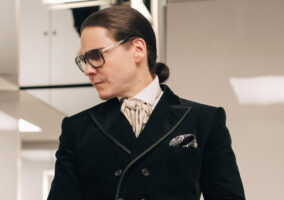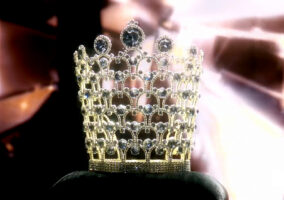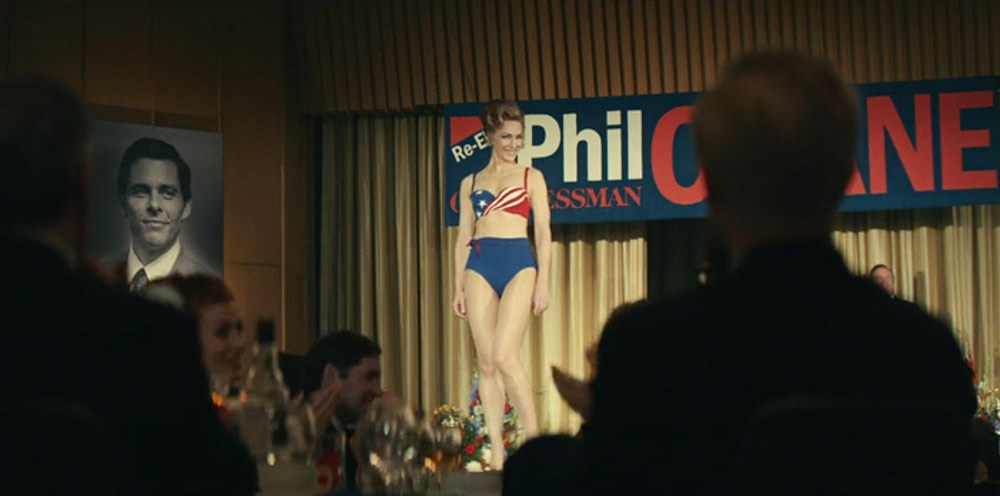
The first episode of the much-awaited Mrs. America devoted itself entirely to an introduction of its ostensible titular character and antagonist, Phyllis Schlafly, as embodied by the slightly too chic and elegant Cate Blanchett. It was a spectacularly acted and directed hour of television, but we concluded with some slight irritation that “They Mad Men‘d her.” Which may not be such a surprise given the series’ focus on mid-Century American sexism and the fact that show runner Dahvi Waller is herself a Mad Men creative team alum. Still, from the bikini show to the marital rape that ended the episode, it felt like the episode was trying to shove every single aspect of sexism at this one character in a short period of time, to the point where it all began to feel a bit heavy-handed. It sets up a question that it doesn’t seem prepared to answer quite yet: How could Phyllis Schlafly devote herself to fighting feminism while more or less living its tenets as an ambitious and career-focused woman in a system that works to deny her rights?”
Directors Anna Boden and Ryan Fleck deftly situated Schlafly in the time and gave Blanchett the freedom to create this woman in her own image. The result is nowhere near an impression of the real Schlafly, but is instead a clearly rendered version of her political brilliance and the way she used the trappings of refinement and traditional femininity to secure power for herself. The show doesn’t quite go there just yet, but the implication is that Schlafly knows full well what she’s doing and doesn’t remotely concern herself with the contradiction. She LIVES the contradiction – and it was evident in the masterful costume design by Bina Daigeler.
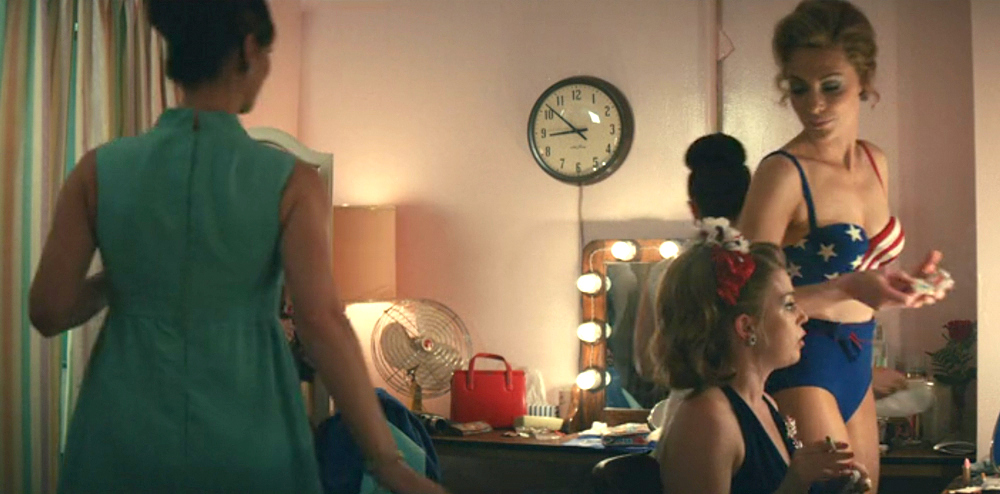
One thing to note in this introductory scene is just how polished and glamorous Phyllis comes across (sheer pantyhose notwithstanding). It stood out to us for a few reasons. First, it made us wonder if this series was going to buff up Schlafly’s image a little. Granted, just about everyone in this series is more attractive than the people they’re portraying, which isn’t exactly unheard-of when Hollywood portrays political figures. Schlafly was considered a somewhat refined figure of midwestern Republican housewifery, but it would be tough to accept any portrayal that tried to make her more glamorous than she was. She was a movement leader (or movement crusher, depending on your point of view), not a “political wife” in the First Lady mode. Second, costume designers have a tendency to make the “look” of the seventies come off a bit more polished than it actually was, given the raging ubiquity of cheap synthetic fabrics at the time. From this opening, our antennae were up to see if this was going to be a more sophisticated and glamorous take on the period. Put a pin in that.
As for symbolism in the costume design, it’s not subtle and it’s not meant to be. We don’t know if Schlafly ever really paraded down a makeshift runway in a bikini, but with this introduction, she is established as both a showily patriotic woman and also a woman operating under the same objectifying and dismissing sexism (note how she was introduced with her husband’s name) as the women she will eventually see as her political enemies.
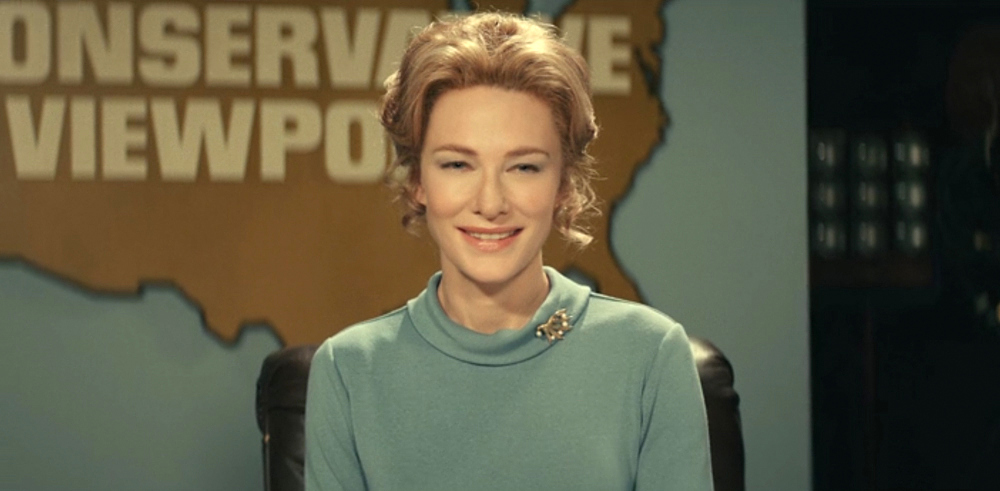
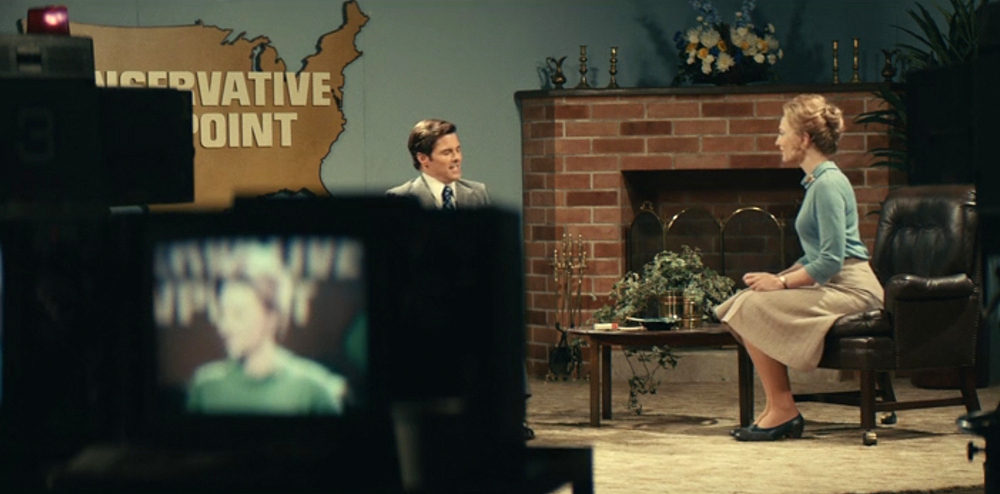
We immediately relaxed when this scene followed. Here is the look of the early ’70s, in all its frizzy-haired, low-rent kitsch. Drink in all the artificiality, from the “plants” to the fireplace to the “leather” chairs.
The Schlafly “look” is pretty much nailed here; straddling that line between ’70s dowdy (good Lord, those shoes) and the kind of respectability drag she was adept at working to her benefit. The point to Phyllis Schlafly wasn’t that she was an elegant or sophisticated figure. Quite the opposite. She was packaged as every middle class white woman’s next door neighbor. Accessibly presentable and respectable.
There’s a rather strongly consistent color theme established here. Phyllis will wear a number of blue-and-brown ensembles in this episode. Costume designers often work within a color theme for reasons of suitability to the actor, adherence to historical norms (it was a common combo of the period, in everything from fashion to decor), and a way of placing the character within the art-directed surroundings. Note how she perfectly matches the rug and the walls. You could easily see Phyllis deliberately picking these colors to make her appear more at home in the setting. She IS “The Conservative Viewpoint” embodied.
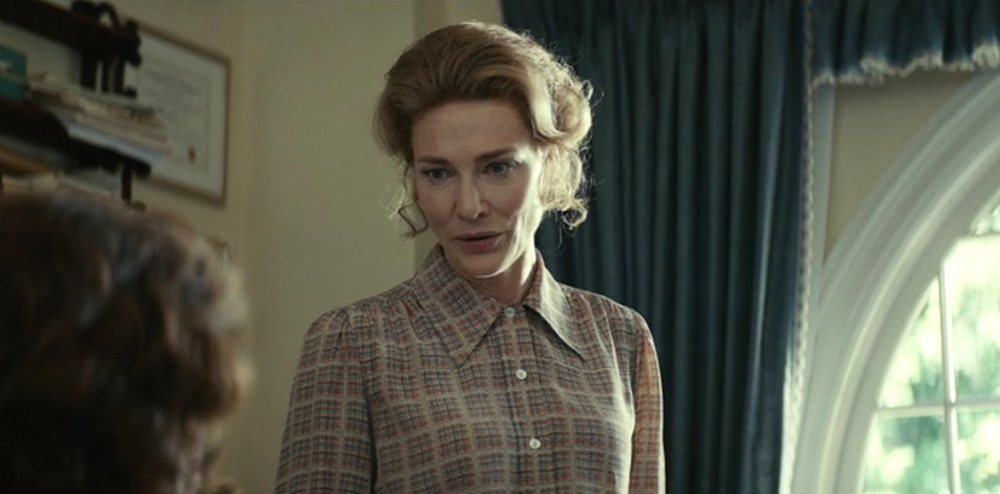
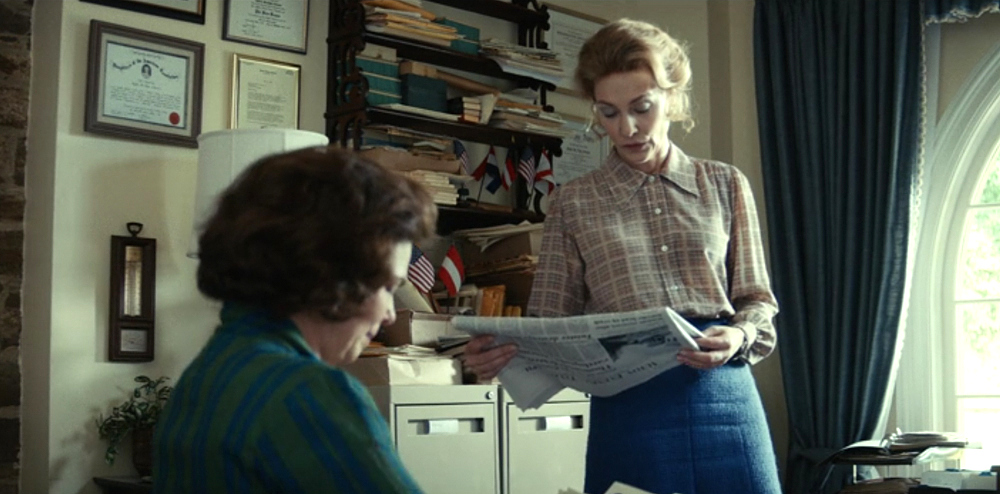
Blue and brown. There’s a neat little trick played here. Phyllis is dressed in a notably more business-like outfit than her sister-in-law. While she matches the color scheme of her home, it’s notable that she’s in the one area that looks least like a home and more like an office. Now look at her in the same outfit, in an actual office:
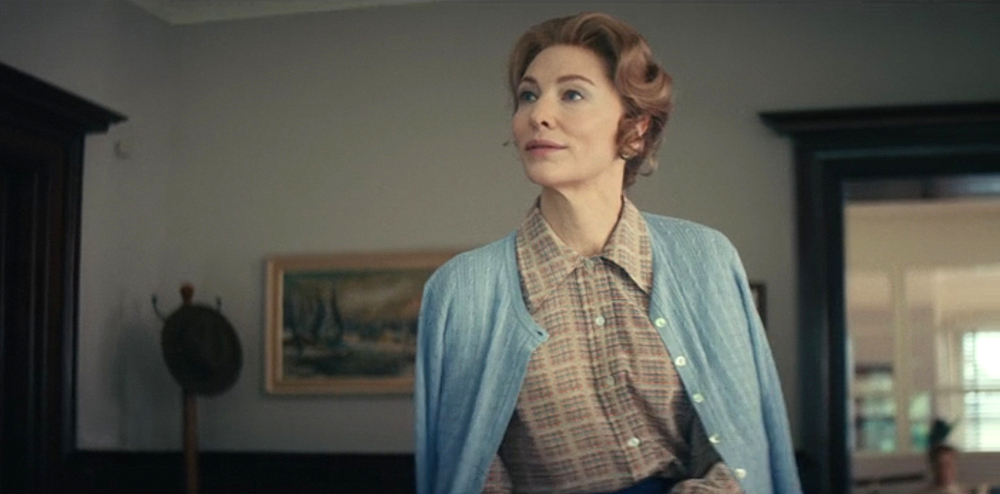
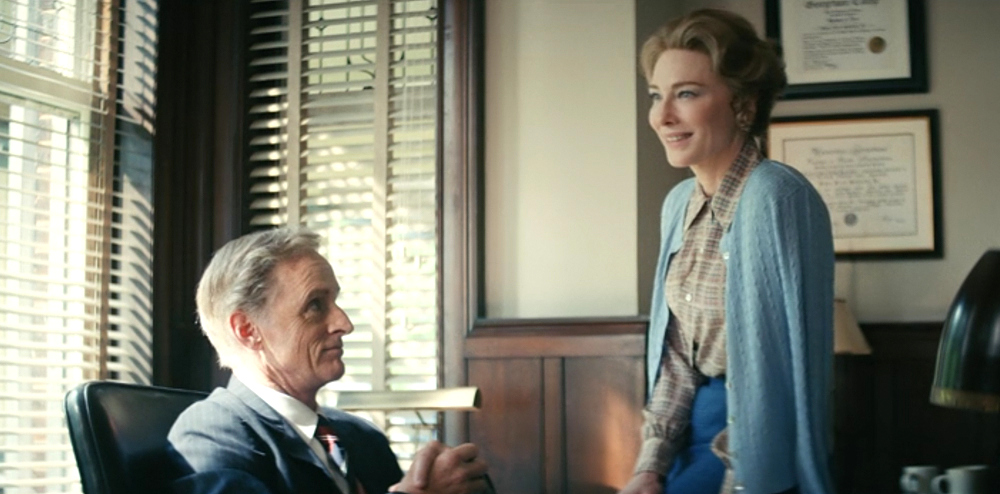
Showing up with a basket of muffins to ask for her husband’s support again in her political aspirations, she deliberately softens her look with a cardigan, looking immediately less businesslike and slightly incongruous with her surroundings. This makes for a nicely subtle underlining of the contradictions of Schlafly’s life. She lived it as a feminist; never denying her own raging ambitions and desire to put them to work out in the world, but she used the respectability politics of middle class conservativism to get what she wanted. She straddled both worlds, as easily as slipping on a cardigan.
Note the tweed skirt. She wears a notable amount of tweed in this episode:
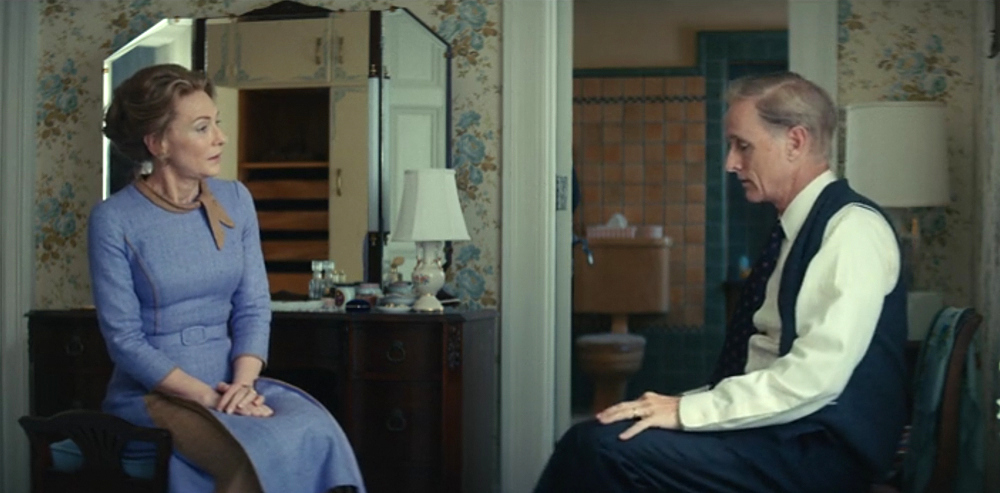
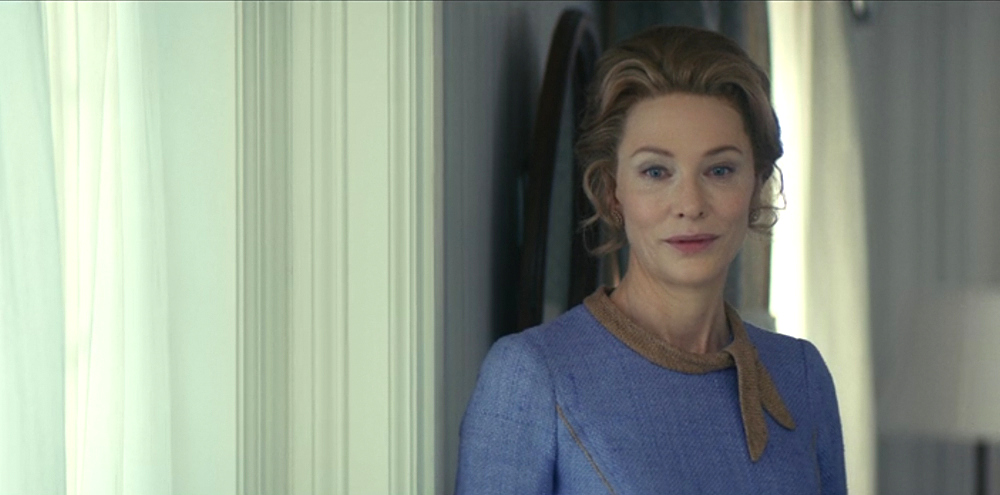
Blue and brown in her similarly colored bedroom, once again playing the role of the pleading wife. More tweed, more respectability fashion. Remember: this is 1971, at a time when women were … well, see for yourself. It’s not that this is unfashionable, but it certainly wasn’t trendy and even for middle-aged suburban women of the time, this is pretty conservative in style.
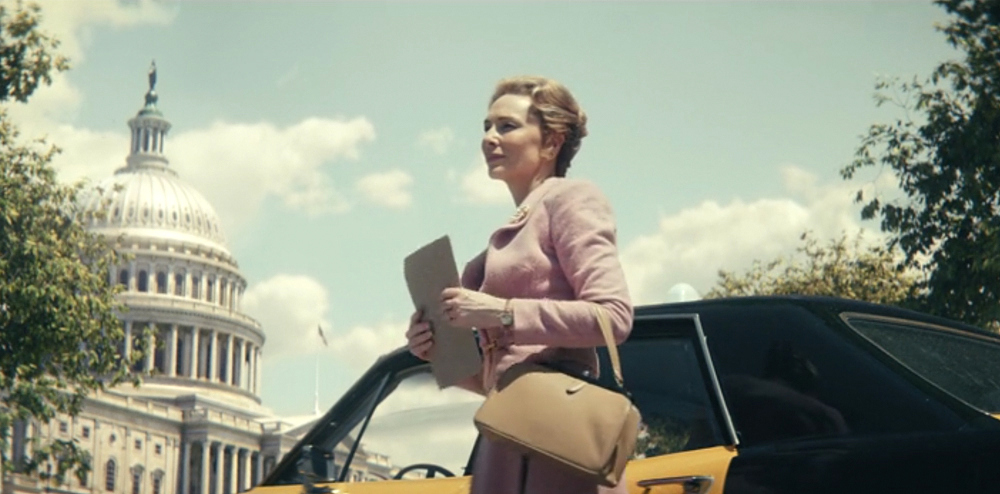
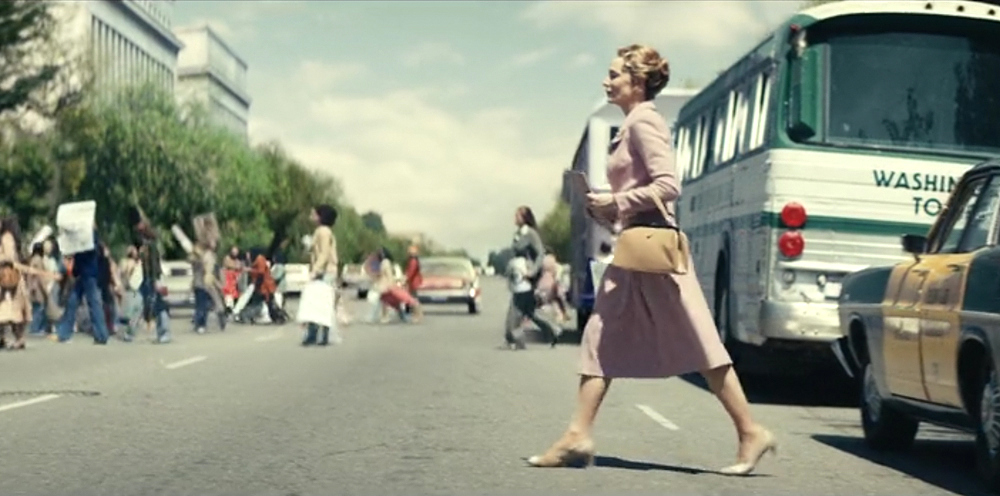
When she makes her trip to Washington, she keeps the un-seventies tweed, but switches out her domestic blue-and-brown color scheme for a feminine pink, rendered in a businesslike suit – again, that sense of contradiction as she asserts traditional domestic femininity while clothed for business and walking the ultimate halls of power. To be fair and accurate about it, she was there to talk about foreign policy, not feminism, but the undertones of her ensemble play out as the scene progresses and she decides to switch her focus to bashing women’s libbers.
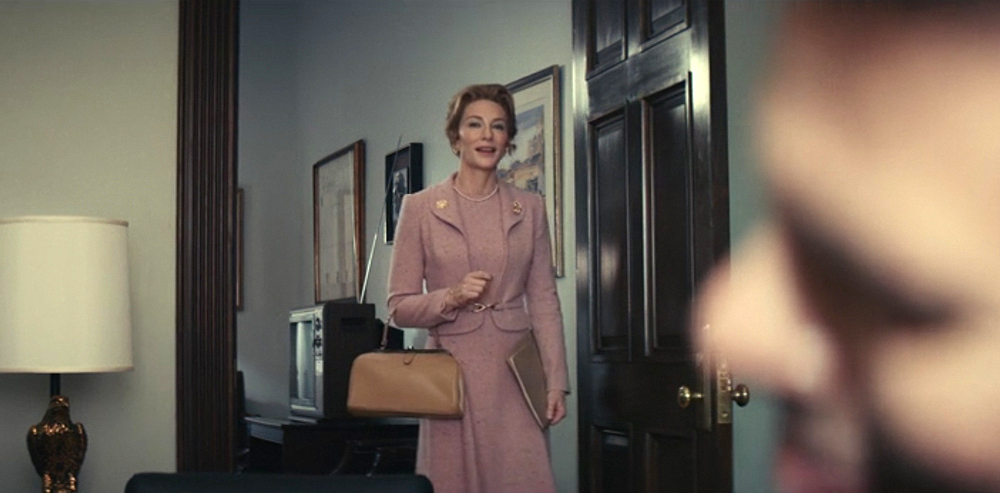
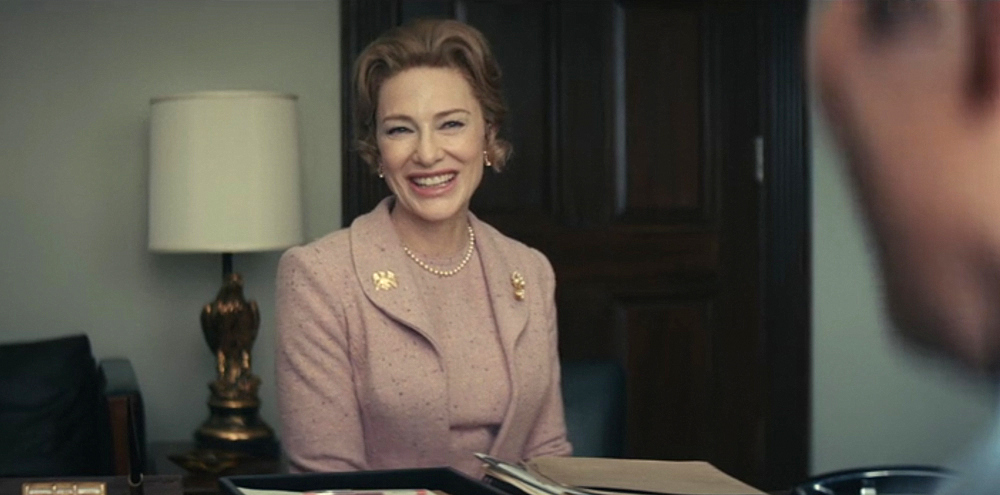
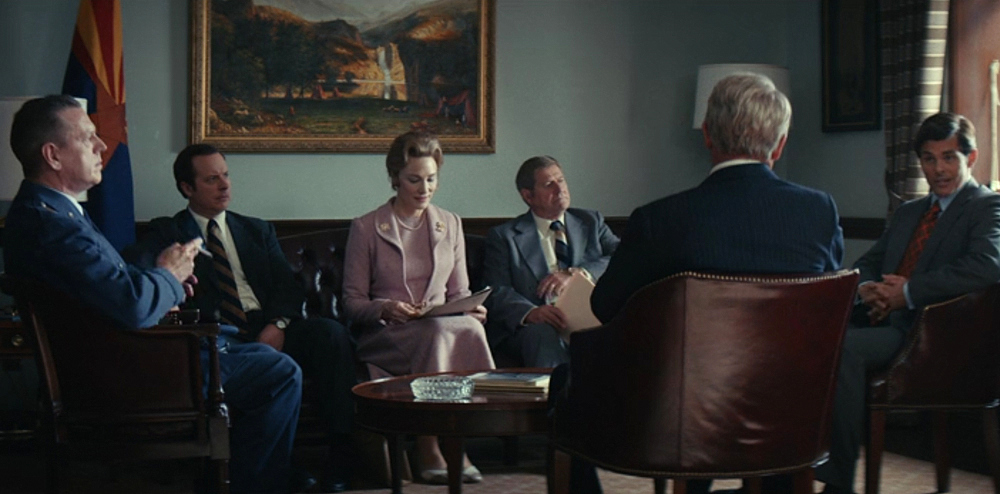
She is not at one with her surroundings or harmonious within the scene in any way. She not only sticks out like a sort thumb, but a very pink and feminine-coded one in this world that practically reeks of masculinity. It’s all leather furniture, landscape paintings and dark business suits in this surrounding. Unlike the faux living room set of “Conservative Viewpoint” or the floral wallpaper of her own bedroom, two places where she reigned supreme and had no problem gaining the upper hand. Here, she struggles because she so clearly doesn’t belong.
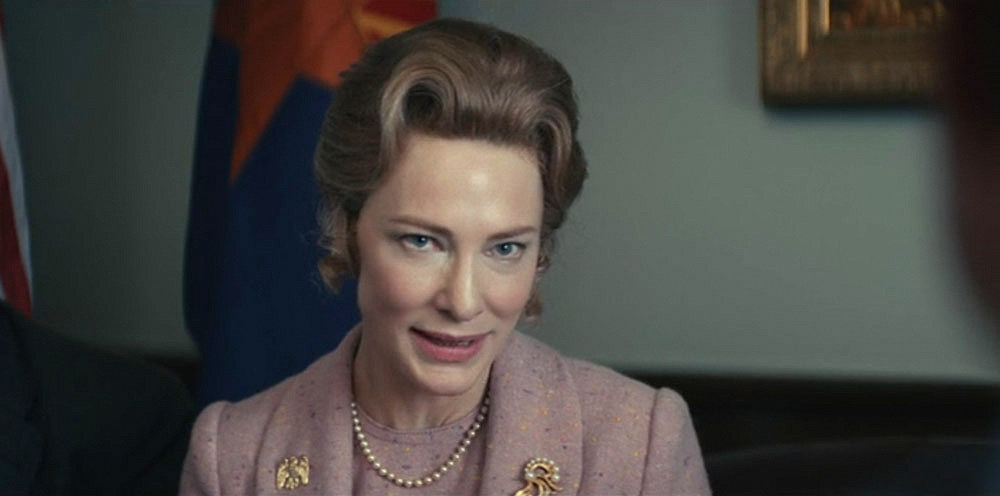
Note how her politics, class station and femininity are underlined with her jewelry: pearls and eagle brooches; practically the DAR uniform.
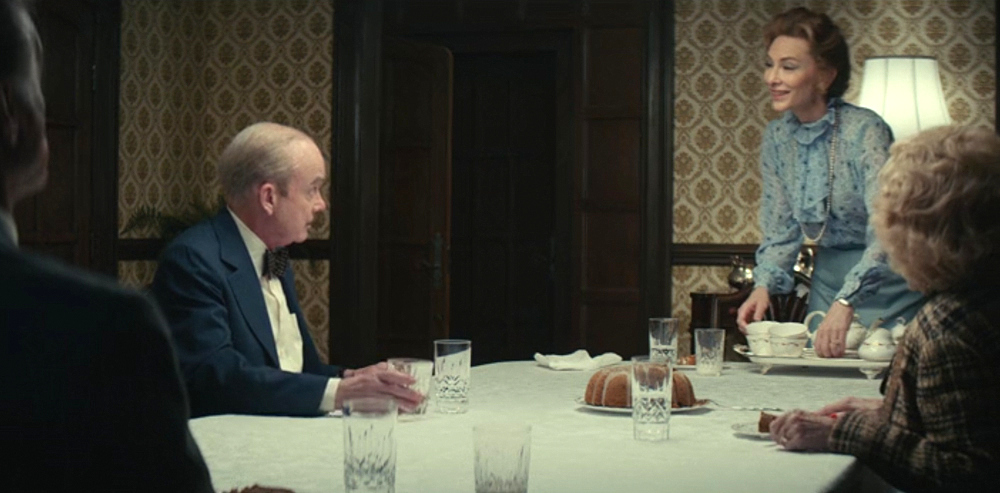
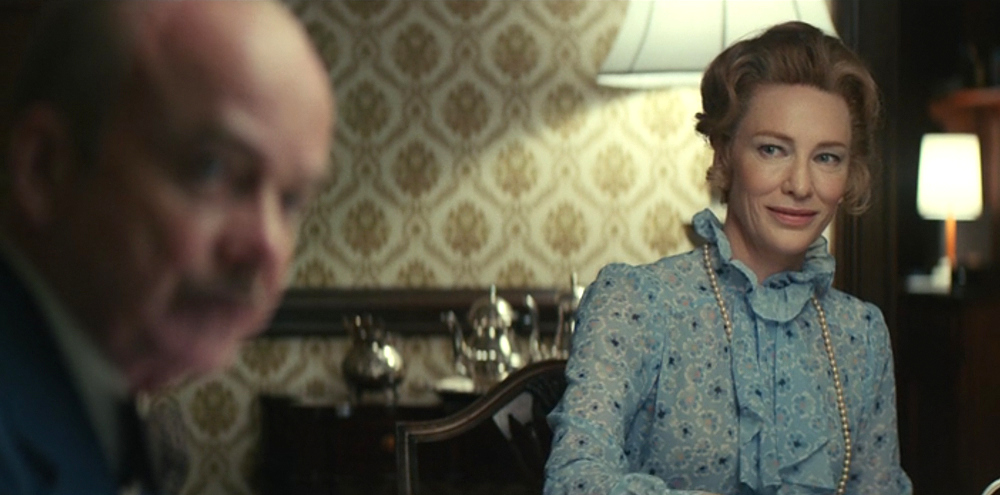
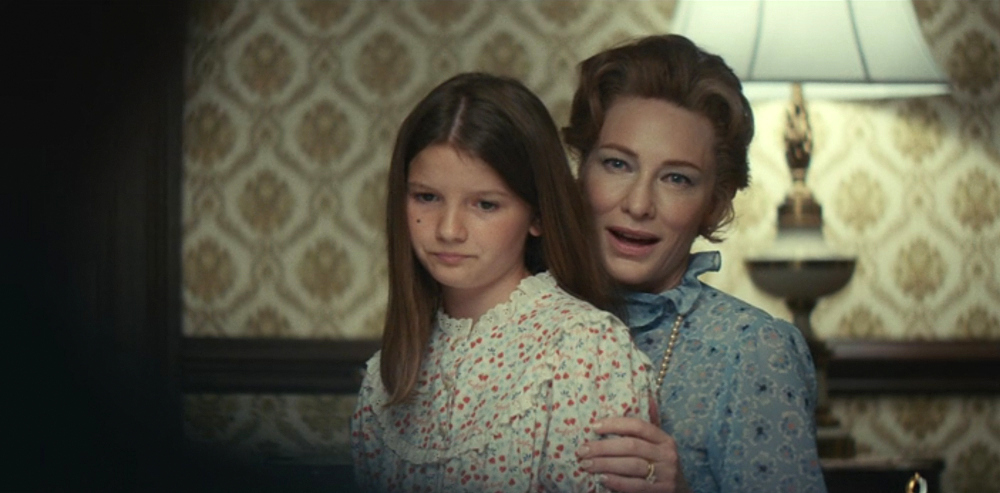
Back home in a domestic blue, with ramped-up feminine touches like a floral (which she has not worn up till now) and a ruffled collar to go with her ladylike pearls. Look at how the two costumes here call to each other, florals and ruffles. Remember that the centerpiece scene of the episode is the Mothers and Daughters luncheon where she launches her initial attack against the ERA and frames it as an attack on motherhood by bitter childless women. Note how she positions her daughter almost like a shield or a prop as she manipulates her husband into letting her mother move in. She is denying the masculinized route to political power that keeps being withheld from her (she announces here that she won’t be running again) and literally utilizing the trappings and imagery of traditional femininity and motherhood as her new route to power.
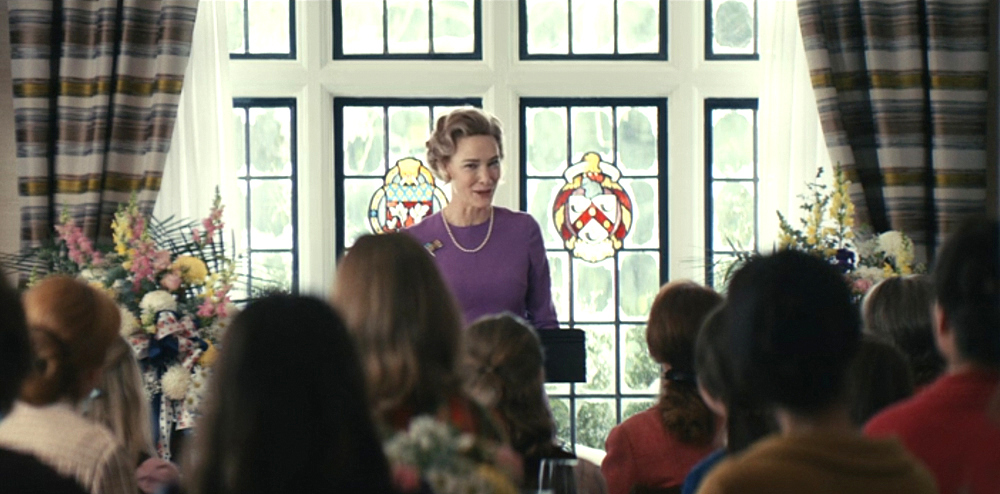
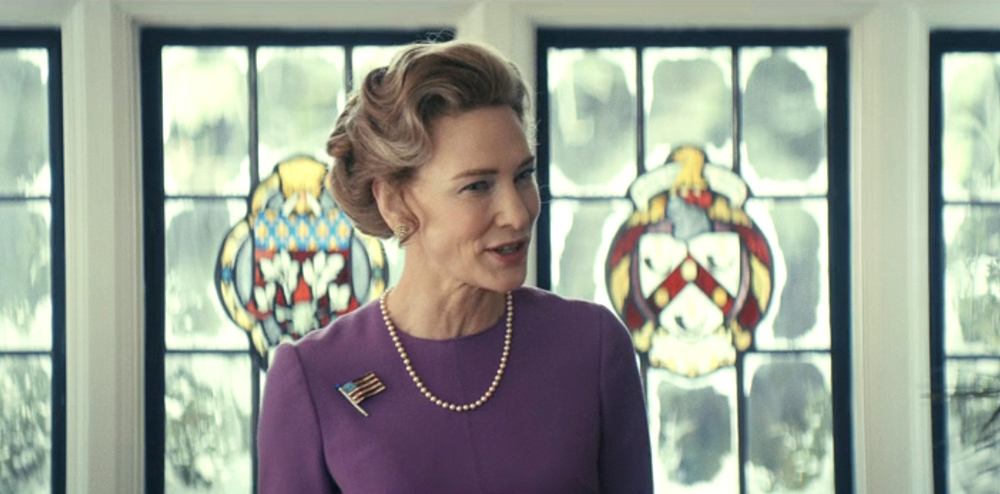
We’re getting closer to the Schlafly uniform: a traditionally feminine yet businesslike look in the Margaret Thatcher mode but with a more American feel to it. The color is bold, the dress is sharp but simple, serving as a backdrop for pearls and her flag brooch, which are what this scene is all about: refined, upper middle-class white femininity tied directly to American patriotism. The Schlafly Doctrine, rendered in clothing.
[Stills: FX via Tom and Lorenzo]
H&M Kaftan Collection Next Post:
Red Carpet Classic Showdown: Beyoncé vs. Rihanna
Please review our Community Guidelines before posting a comment. Thank you!

